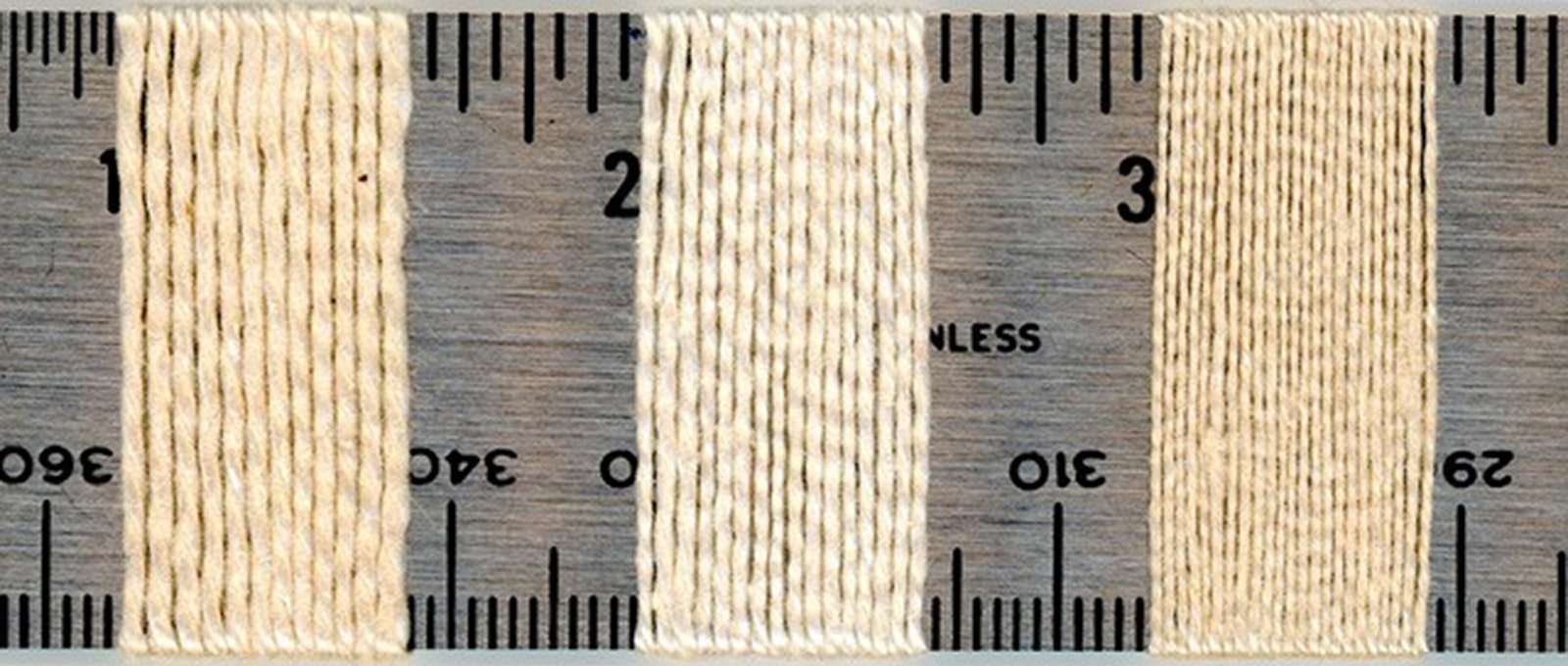I‘ve only been weaving for a short time, first on a rigid-heddle loom and now on a floor loom. I always determined my warp sett by using the wraps on a ruler, but after some discussions with Facebook weaving groups I find that this is not always the best way to get my sett.
I‘m quite confused. How should I learn the sett for different yarns?
Sandra
Hi Sandra!
When you’re deciding on a sett, there are three basic factors about your project you must take into account: the weave structure, the yarn, and the desired hand of your finished cloth.
The Weave Structure
Wrapping a ruler gives you the information you need to weave a balanced plain weave using that yarn. If you wrap 24 threads in an inch on the ruler, the sett for a balanced plain weave in that yarn would be 12 ends per inch. The weft, as it goes over and under each of those threads, will take up the same space a warp thread takes up.
If, however, you are weaving 2/2 twill, the weft will skip one of those spaces and go over two warp threads. The sett will, therefore, need to be a little closer than 12. If you are weaving a 1/3 twill, the weft skips two of those spaces and so the sett might need to be even closer. With 8-shaft twills, floats can be over even more threads. Therefore to determine the sett for a particular balanced twill sometimes requires that you make an educated guess and then sample. (You can read more about sampling here and here.)
If your cloth is warp-emphasis or warp-faced (more warp threads per inch than weft threads per inch), you can try to place the warp threads as close to each other in the wrap as you want them to appear in the cloth while imagining the weft and its density, and use that number as the sett. The sett for a weft-faced cloth will depend on the weft fiber. In both cases, sampling your draft using different setts (and wet-finishing those samples) will give you the clearest indication of the right sett.
The Yarn
Cotton, linen, and silk yarns can usually be sett following the information gained from a wrap.
But wool, chenille, novelty, and textured yarns each require special consideration. When you wrap a wool yarn, allowing each wrap to be placed beside the previous one without pushing them together can produce the room needed for the yarn to full.
The setts for chenille and novelty yarns will depend on the characteristics of the specific yarn. Usually, with these yarns, the goal is not a balanced plain weave or twill. And again, you’ll likely need to sample to learn the correct sett.
The Finished Hand
Your thinking about sett will also depend on the desired hand of the finished cloth.
If you want a balanced, firm plain weave for placemats, runners, or rugs, you will choose a closer sett than for scarves and shawls (since a wrap usually tells you the sett for a firm plan weave, choose a slightly more open sett for a softer hand).
With wools, the biggest consideration will be the finishing process. The more you wish the wool to full and shrink, the more open both warp and weft setts will need to be.
Resources
Because some of these decisions are hard to make without sampling, two useful aids to determine sett are the Master Yarn Chart and back issues of Handwoven.
The Master Yarn Chart gives the sett for a balanced plain weave for many of the yarns that have been used in Handwoven, along with photos of the yarns. The chart suggests a more open sett for lace weaves and a closer sett for twills, but those specific numbers are dependent on both the weave structures and yarns, so you should consider them a starting point as you sample.
For a yarn or weave structure you are unsure about, the most instructive thing you can do is leaf through back issues of Handwoven to find a project that is similar to the cloth you want to make. The project photo will reveal the look and hand of the cloth, and project instructions will include the specific yarns and setts required to weave it.
Using Handwoven can sometimes allow you to skip the sage weaver's advice (which is still sage advice): Sample! Sample! Sample!
Madelyn
If you have a weaving question please email Madelyn!
Originally published March 21, 2018. Updated July 29, 2024.

